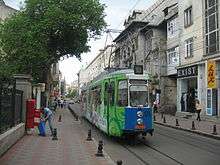GT4 (Stuttgart)
| SSB GT4 | |
|---|---|
|
GT4 in Stuttgart | |
| Manufacturer | Maschinenfabrik Esslingen |
| Constructed | 1959–1965 |
| Capacity |
47 (Seated) 124 (Standing) |
| Specifications | |
| Train length | 18,800 mm (61.7 ft) |
| Width | 2,200 mm (7.2 ft) |
| Height | 3,160 mm (10.37 ft) |
| Doors | 3 |
| Articulated sections | 1 |
| Maximum speed | 65 km/h (40 mph) |
| Weight | 19,500 kg (43,000 lb) |
| Power output | 2 x 100 kW Motors |
| Bogies | 2 |
| Track gauge | 1,000 mm (3 ft 3 3⁄8 in), 1,435 mm (4 ft 8 1⁄2 in) |
The GT4 (from German: Gelenktriebwagen 4-achsig, which translates as 4-axle articulated tramcar) is a GT4 type tramway vehicle built by Maschinenfabrik Esslingen.
History
Only 380 were produced of which 350 were delivered to the Stuttgarter Strassenbahnen, the public transport operator of Stuttgart. The remaining 30 vehicles were delivered to Freiburg (19), Neunkirchen (Saar) (8) and Reutlingen (3). The 350 Stuttgart-vehicles were uni-directional, had three double-doors, and were built to 1,000 mm (3 ft 3 3⁄8 in) gauge. The remaining cars were bi-directional and built with 1,000 mm (3 ft 3 3⁄8 in) gauge, with the exception of the Neunkirchen cars, which were built to 1,435 mm (4 ft 8 1⁄2 in) standard gauge. They also had four powered axles whereas two powered axles was the standard variant. Tram service in Neunkirchen was abandoned in 1978.
With 107 trams in service, as of 2012, the largest operator of GT4 is RATP, the public transport company in Iaşi, Romania.[1]
Technics
_06.jpg)
The GT4 was developed because the longer 6-axle articulated trams with Jacob's bogies, such as the GT6, were not suitable for the Stuttgart network, which had a large number of sharp curves and steep gradients due to that city's hilly topography.
The design of articulation is unique: Both bogies are connected by an underframe, upon which the two halves of the tram body rest. When the tram drives around a curve, the underframe prevents the body from overhanging the inside of the curve, allowing tighter clearances and more flexibility than a non-articulated tram.
On standard gauge vehicles only the inner axles on each bogie were powered, therefore the wheel notation was (1A)(A1). 2/3 of the vehicle weight were rested on both powered axles.
The bi-directional variants have a second driver's cab and additional side doors, unlike the uni-directional models.
Trailers
The GT4 can operate in double traction mode. Some vehicles had powered trailers and therefore, no driver's cab. This was the case with 24 vehicles of the first series, 30 in the second series, 98 in the third and fourth series and eight in the fifth series, altogether 180 coaches were affected.
Sale to other cities


As Stuttgart put the Stuttgart Stadtbahn standard gauge light rail system in operation from 1985 onwards, some surplus GT4 cars were sold to other cities:
- Iaşi (Romania) - 107 cars
- Augsburg - 40 cars (23 cars later resold to Iaşi)
- Halle - 38 cars (27 cars later resold to Iaşi)
- Nordhausen - 12 cars (3 cars later resold to Iaşi)
- Ulm, Halberstadt, Brandenburg an der Havel, Arad (Romania) and Kōchi (Japan) - unspecified numbers
Some vehicles were destroyed or damaged beyond repair during a great fire in the Feuerbach depot in Stuttgart in 1986.
The bi-directional cars originally delivered to Reutlingen (59,60 and 61) were later sold to Ulm. The Ulm workshop rebuilt them to unidirectional cars (11,12 and 13).
In 1989, a longer car set was rebuilt: Two unidirectional vehicles (SSB 714 and 735) were joined together as one bi-directional vehicle. The vehicle had no additional doors, so only the two doors in the direction of travel were usable.
See also
References
- ↑ The RATP fleet (Romanian)
External links
| Wikimedia Commons has media related to SSB GT4 tram. |